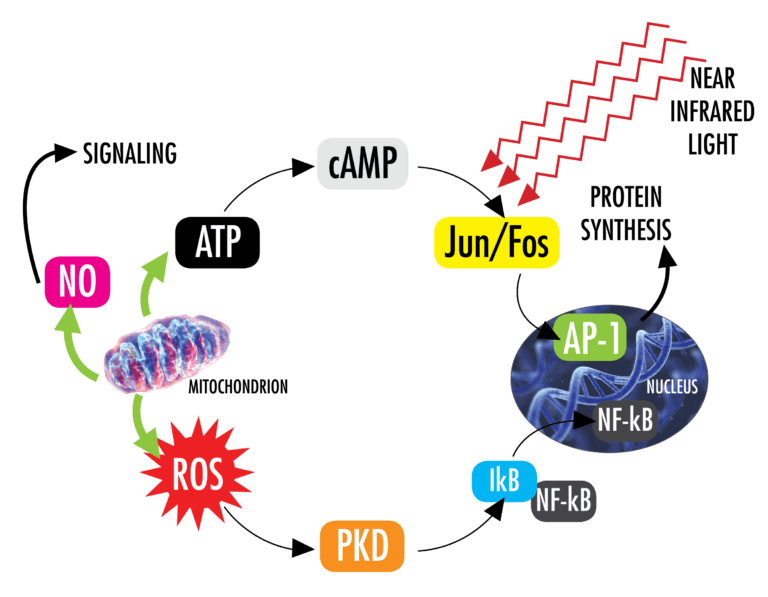The Buzz on Photobiomodulation
Wiki Article
How Photobiomodulation can Save You Time, Stress, and Money.
Table of ContentsMore About PhotobiomodulationAn Unbiased View of PhotobiomodulationFacts About Photobiomodulation RevealedThe Main Principles Of Photobiomodulation
Laser therapy is a clinical therapy that uses concentrated light to promote a process called. Throughout PBM, photons go into the cells and connect with the cytochrome c facility within mitochondria. This communication triggers a biological waterfall of events that causes an increase in mobile metabolism, which can along with speed up the healing procedure.There is consensus that the application of a therapeutic dosage of light to impaired or useless tissue results in a mobile response moderated by mitochondrial mechanisms. Photobiomodulation. Studies have actually shown that these modifications can impact discomfort and inflammation, along with, tissue fixing
Modifications in ATP, reactive oxygen types and nitric oxide adhere to light absorption by Cc, O. These impacts are redox state and dosage reliant. In hypoxic or otherwise stressed cells it has actually been shown often times that complying with, nitric oxide is released, ATP is raised and oxidative anxiety is reduced [27-31]

Indicators on Photobiomodulation You Should Know
PBM tools have actually been removed for advertising by FDA with the Premarket Notification/510( k) procedure as adjunctive tools for the temporary alleviation of pain. These clearances were based on the presentation of scientific data to sustain such insurance claims (Photobiomodulation). In this treatment, a light resource is put near or touching the skin, permitting the light energy (photons) to pass through cells where it communicates with chromophores located in cells causing photophysical and photochemical modifications that result in changes at the molecular, cellular and tissue levels of the bodyInterestingly, recent research indicates that light can boost performance in normal cells and cells. The potential applications of PBMT are countless and are being discovered experimentally at the fundamental science, pre-clinical and clinical degree. The existing clinical uses are for the alleviation of pain and inflammation and the therapy of sports injuries.

The therapy specifications and number click this site of sessions required for PBMT are reliant upon location and cause. PBMT typically needs even more than one treatment for optimum discomfort alleviation.
The Photobiomodulation Statements
Therapy specifications for PBMT were initially established using cells artificial insemination and in little animal versions. These treatment parameters usually had a low irradiance and fluence and functioned well for cutaneous applications. When medical professionals started to utilize PBMT to deal with structures that were located much deeper in the body, they used these criteria with adverse results.
We now recognize that these negative research studies were due to incorrect tool and treatment specifications for transcutaneous therapy of much deeper frameworks. Current breakthroughs in laser treatment tools and more study right into the proper does have continue reading this actually dramatically enhanced the outcomes of PBMT. For dealing with deep tissues, the wavelength of light used figures out the deepness of infiltration into a cells.
It is vital that a medical professional makes use of the appropriate wavelength of light and criteria to treat a problem. One wavelength and one collection of treatment specifications will not work for all conditions. Adverse side effects have not been reported from using PBMT (Photobiomodulation). Updated June 27, 2016Juanita j
Light therapy is a non-invasive therapy that functions by raising the ability of the cell to produce energy (ATP) to heal the location being dealt with. Therefore, it can lower swelling, swelling, and pain in the area. Research in this location is expanding, with more extensive research study papers connected listed below for those that would love to find out much more.
The smart Trick of Photobiomodulation That Nobody is Talking About
In the initial experiment, Dr. Endre Mester, utilized cut rats and observing exactly how the laser affected their capacity to grow hair contrasted to the group that was not getting LLLT. He located that the group of computer mice receiving LLLT had the ability to grow their hair back faster than the group of computer mice that didn't get LLLT (Hoon C, et alia; 2012).This treatment is described by doing this to distinguish the difference between the lasers some careers use to reduce (eg. in surgical treatments, or oral procedures). Low-level light therapy is painless, non-invasive therapy. It is made use of to decrease inflammation, swelling, and persistent joint disorders, decrease discomfort and increase wound recovery of nerves and tissues (Hoon C, et al; 2012).
LLLT has a biphasic feedback, suggesting that lower doses are normally attended be more beneficial than higher doses. That being stated, doses greater or lower than the optimal dosage doesn't affect (Hoon C, et alia; 2012). For this reason, it can be tough to have researches on LLLT with numerous criteria.
Some firms integrated the 2 (LED and laser) to give a much more well-shaped therapy since lasers can permeate much deeper than LED and infrared light his response (Norman Doidge, The Mind's Method of Recovery, 2015). During treatment, the area that is being treated is subjected to LED light from a Bio, Flex Laser, which is at 660 nm wavelength, followed by infrared light at 830-840 nm wavelength.
Report this wiki page